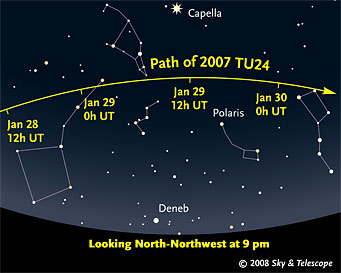소행성 2007 TU24는 지난해 10월부터 관측되어 다가오는 1월 29일 지구에 최접근 할 것으로 알려졌다.
일각에서는 최접근 거리가 0.0045AU이기 때문에 지구에 부딪힐지도 모른다는 우려를 나타냈지만,
다행히 지구와 부딪히지는 않고, 화성과도 부딪힐 확률이 극히 적은 것으로 계산되었다.
하지만 별을 보는 우리에게 우리의 생명을 위협하는 소행성을 걱정하기 보다는
소행성을 관측할 수 있는 최적의 기간임을 깨달아야한다.
소행성의 위치는 다음의 데이터를 참고하라.
JPL 또한 소행성 2007 TU24의 정보를 제공하고 있다.
http://neo.jpl.nasa.gov/news/news157.html
JPL에서 얻은 소행성의 위치 자료
시간 29,30일 / 관측지 서울 / 데이타 시간간격 30분 일 때 소행성의 위치 데이타
미국 sky&telescope지의 기사글
http://www.skyandtelescope.com/observing/home/14346437.html
As I sit in my office writing this, an 800-foot-wide chunk of rock is less than 2 million miles away and headed almost straight toward me. No need to panic, though! JPL's Goldstone Radio Telescope, usually used to communicate with satellites, has pinpointed the asteroid's location within 100 feet by radar sounding. At its closest approach, January 29th at 8:33 Universal Time, asteroid 2007 TU24 will still be a comfortable 344,000 miles from the center of Earth. That's 554,000 km, or 1.44 times the mean distance to the Moon.
So we're not in imminent danger of destruction — much as that may disappoint the conspiracy theorists. In fact, the only perceptible effect that this asteroid will have on Earth is that several professional telescopes (radio and optical) will be diverted to look at it, and lots of amateur astronomers will be outside trying to see and photograph it.
On the night of closest approach, Monday-Tuesday (Jan. 28-29), the asteroid is predicted to be 11th magnitude or brighter all night for viewers in the Americas, making it visible in small telescopes and large binoculars. At its peak, about 8 hours after closest approach, the asteroid is forecast to be magnitude 10.3. And the brightness should fade fairly slowly, so TU24 will still be pretty easy to catch on the night of Jan. 29-30. (The strikingly asymmetric light curve is due to the angle of sunlight falling on the asteroid.)

Stargazers at mid-northern latitudes can see asteroid 2007 TU24 all night during its closest approach, because it's passing quite close to the North Star. To convert from Universal Time (UT) to North American time zones, subtract 5 for EST, 6 for CST, 7 for MST, and 8 for PST. So 0h Jan. 29 UT is 19h (7 p.m.) Jan. 28 in the Eastern time zone. Click here to download a more detailed chart in PDF format. S&T Illustration
Unfortunately, it's impossible for us to publish detailed finder charts, because this asteroid will race across one-fifth of the celestial sphere in a single day. We'd need a small book to chart such a huge swath of sky in sufficient detail to locate the asteroid by star-hopping. Moreover, parallax is huge for an object so close. The asteroid's position among the stars can vary by more than one degree depending what spot on Earth you're viewing from. So your best bet is to go to JPL's Horizons website and generate ephemerides for your particular location. You can then plot these on your favorite star atlas on enter them into your computer's Go To controller.
It's worth the effort, though. At its fastest, TU24 will be traveling 3½° per hour through the "fixed" stars. That's seven times faster than the Moon, and almost half the speed that the surrounding stars drift across the sky due to Earth's rotation. The motion should be directly visible at high magnification through a telescope with a tracking drive.
Click here to download a detailed chart in PDF format showing the asteroid's position, distance, and predicted brightness at 12-hour intervals. And for more information on this hunk of rock, see the NASA/JPL press release.
'별보기 > 하늘 소식' 카테고리의 다른 글
| 제 16회 천체사진 공모전 (0) | 2008.02.02 |
|---|---|
| 소행성 2007 TU24의 첫 사진 공개 (0) | 2008.01.29 |
| Amazing Space: Tonight's Sky 2008, 01 (0) | 2008.01.23 |
| 07년 제19회 한국 아마추어 천문인의 밤 '별잔치 (STAR PARTY) (0) | 2007.11.02 |
| Comet Holmes 안시관측 가능 (0) | 2007.10.26 |
 invalid-file
invalid-file invalid-file
invalid-file